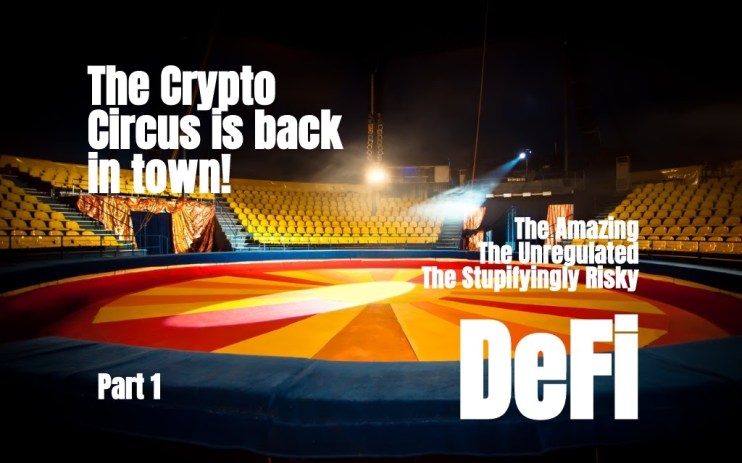The Crypto Circus is Back in Town! This Year’s Star Attraction? DeFi (Part 1)

Roll up! Roll up! Step right up Ma’am! You too Sir, and yes, bring your kids!. The show is about to start. The most spectacular (crypspacular?) Razzle-Dazzle on the planet is just behind this curtain. Can’t you hear the crowds roar on social media?
It’s our star attraction for this year. It promises access to financial products and services with none of those oh-so pesky regulations. Giving you fine people the chance to make double – or even triple-digit returns on your investments!!
What is it?
It’s DeFi! And you better get in quick, or you might miss out!
Oh. And please don’t ask too many questions. Whatever you do, don’t look at the state of the code or the people running the circus. Just stare at the flashing lights and get swept up in the hype.
It seems like in the past two weeks, DeFi has been dominating the media cycle in the cryptocurrency and blockchain spheres.
This is a perfect time to step back, take a collective breath, and REAL about DeFi..
DeFi is shorthand for decentralised finance. Decentralised finance promises to recreate the (already broken) financial system by offering many of the same (tired old) financial products, but in a way that doesn’t involve any of those (government-mandated) intermediaries (like banks).
DeFi is shorthand for decentralised finance. Decentralised finance promises to recreate the (already broken) financial system by offering many of the same (tired old) financial products…
They are starting with something simple, like loans. Decentralised loans allow people to borrow and lend cryptocurrency amongst themselves. Borrowers put up collateral in the form of a different cryptocurrency.
These systems are designed so that anyone can lend or borrow. That means that there are no checks for borrowers, naturally meaning a much greater chance of default. Collateral for these loans is also cryptocurrency. With the high price volatility of crypto, these loans can very quickly become under collateralised and then automatically liquidated – to the understandable horror of the borrower. Nevermind the fact that if the network is running slow (and when has crypto EVER been not slow), the process can take time, and the individuals who put up their cryptocurrency to lend can also wind up taking a massive shortfall hit.
The entire system is leveraged on the basis that all cryptocurrencies will only ever go up and that all stable coins will execute correctly and remain stable. Yeah…RIGHT.
Some of the loans claim that “interest” is paid on the loans. Interest is a simple and easy to understand word that reflects compounding and some other characteristics of the loans, but it means something completely different in Defi. To make things even more confusing, every DeFi product provides a different method of calculating “interest” (So much for ‘freeing’ people from so called ‘archaic’ financial systems where interest is clearly understood and regulated)
Another (in)famous DeFi product is “staking”. By staking your cryptocurrency and thus taking it out of circulation, you can earn rewards. Allegedly, if enough people ‘stake’ they can reduce supply and drive up the price. No one thinks about what happens (i.e. the fallout) when everyone wants to ‘un-stake’.
Staking was initially conceived as a part of consensus algorithms that are an alternative to bitcoin’s proof of work.
Bitcoin miners compete to solve a cryptographic puzzle and every computer requires a lot of electricity (and generate a LOT of heat) to run the competition. This form of achieving consensus and deciding who can write to the blockchain is called Proof of Work.
With Proof of Stake, network participants (called forgers as in forging steel – not forging documents) would put a fixed amount of cryptocurrency “at stake”, and the network would pull a random winner from the pool to win the block reward. The more cryptocurrency that you put at stake, the larger your chances of winning. And, if you won the block reward and misbehaved by confirming false transactions or entering incorrect data into the chain, you would forfeit your stake.
Staking, in this context, had a balance of risk and reward, with a clear utility in delivering value to the network while reducing the massive environmental fallout of Proof of Work mining.
DeFi staking is entirely different. It offers no utility. It delivers no value. It has significant (both misunderstood and misrepresented) risk. And the rewards are often in the form of some other cryptocurrency with no inherent value (subject to the extreme volatility outlined earlier)
DeFi staking is entirely different. It offers no utility. It delivers no value. It has significant (and both misunderstood and misrepresented) risk.
New companies come to the market with DeFi products almost daily. Some are offering derivatives and other complex financial products (typically reserved for professional investors and traders and for good reason!) Others are offering lines of credit so that crypto traders can leverage up their positions and play the arbitrage game across multiple centralised exchanges.
DeFi is the buying, selling, loaning and borrowing of ‘worthless supermarket loyalty points’ which are created out of thin air. But that doesn’t seem to be slowing anyone down.
Despite all this, maybe you are one of those that loves the hype and energy and excitement of the casino and carnival lifestyle. In which case, have fun. When using DeFi – and putting money in crypto in general – you should always follow the Three Day Vegas Rule.
Never spend more than you would on a three day trip to Vegas including your flights and hotels and at the roulette wheel. The experience will be the same. You’ll meet a lot of really crazy amazing people. You’ll have a whole lot of fun. You might win big, but you’ll most likely lose it all. (Unless you are the one running the casino, the ‘house’ usually always wins)
Next week I’ll be outlining how the latest trend in decentralised crypto exchanges is gaining a lot of traction for crypto projects. We’ll be taking a look at how these systems can collapse under the weight of their popularity and ‘bugs’ in the smart contracts.
And in week three, I’ll discuss the anti-regulatory nature of DeFi. Remember, ICOs were loved and revered because they were unregulated – until a bunch of retail consumers lost their life savings, and the regulators had to step in and burst the whole bubble.
Get in touch with us info@blockchainrookies.com / Twitter @igetblockchain

Troy Norcross, Co-Founder Blockchain Rookies
Twitter: @troy_norcross